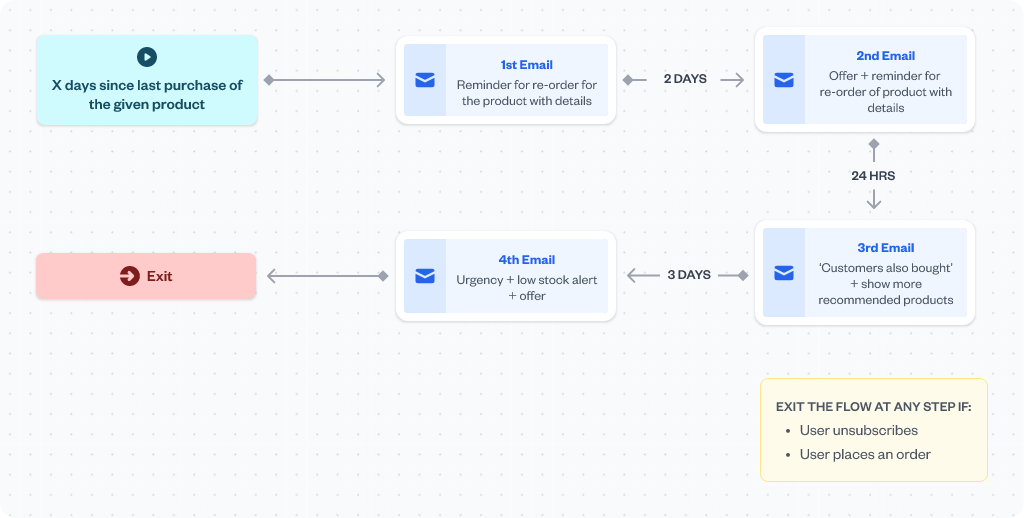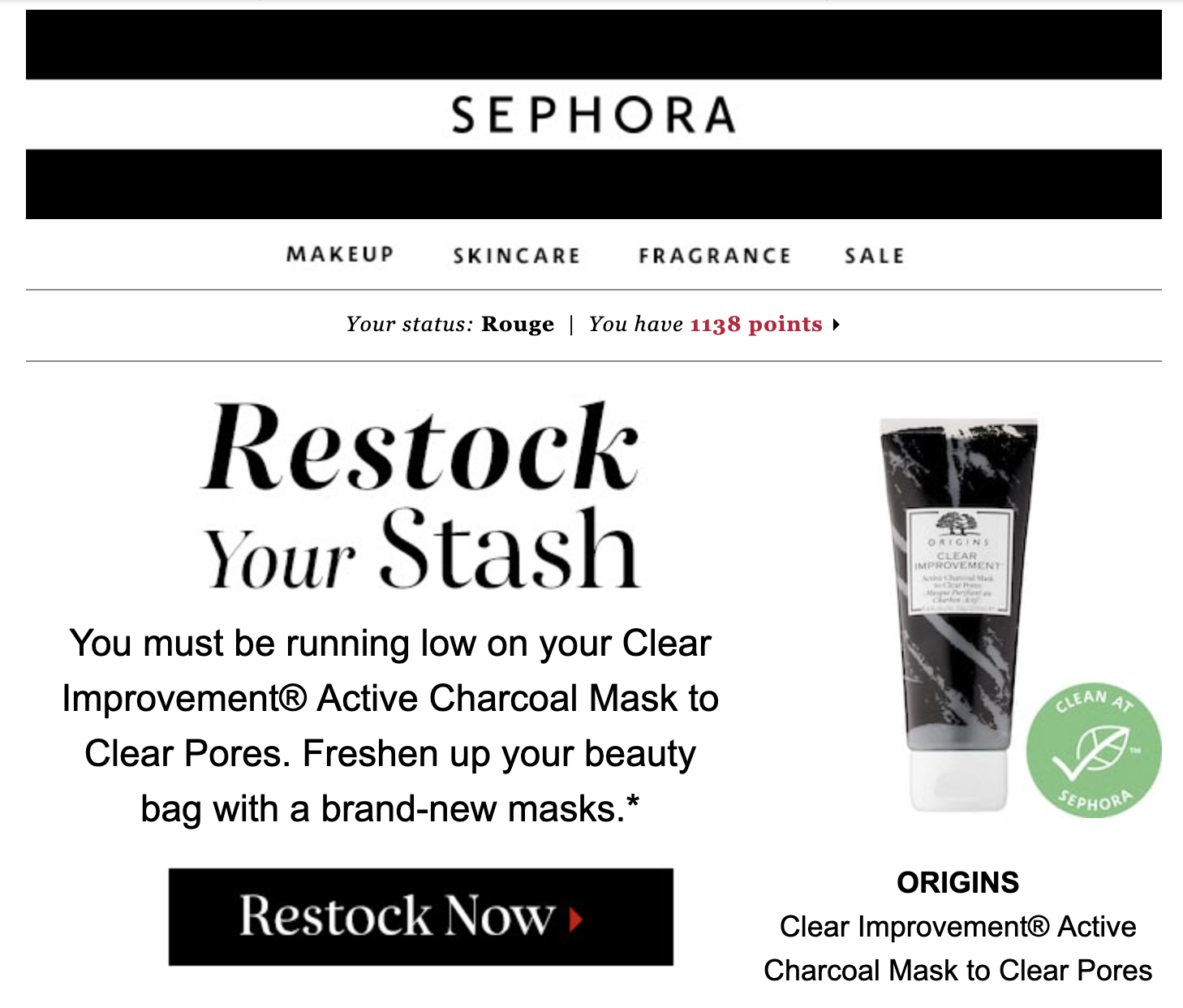Learn the basics of ecommerce replenishment emails.
As online retailers, repeat sales have become tougher than ever. It’s not a secret that consumers have too many options available to them which makes them pickier when it comes to re-ordering products.
Because they are presented with a lot of items, each eCommerce company’s marketing team has to come up with unique strategies to hold the customers’ attention and make them buy from them again.
So, how do you boost the number of repeat purchases from your customer base? One of the most effective ways is through replenishment emails.
If you’re just building your eCommerce store or already have one but aren’t seeing good results, then this article is for you.
Today, many customers don’t come back after making their first purchase. You certainly don’t want that happening to your online store, do you? This article will help you understand why you need repurchase email strategies and how to execute it.
What are replenishment emails?

Think about this for a second – what company, for example, is not taking advantage of email marketing? It’s all over the place – online and offline, companies (big and small) are looking to make their emails more effective in getting more results.
Replenishment email marketing is designed to remind customers that they need to reorder products or services. They’re usually sent after a certain period of time has passed since their last order, and they can be customized by the vendor to include specifics about the customer’s past purchases.
As their name suggests, replenishment emails are sent to people who have already bought from your store. The aim is to persuade them to buy again from you and increase the chance of repeat purchases. This is why these types of emails should only be sent after someone has bought something from your store.
Let’s say John buys some shoes from your online store on January 1st, 2018. You then send him an email on January 2nd saying: “Thanks for buying those shoes! If you’d like more pairs like these, check out our new collection.”
Why do you need replenishment emails?
The answer is simple – because it works!
The statistics show that replenishment emails have an average open rate of 50-60% and an average click rate of 40-50%.
Replenishment emails are also known as “re-engagement” or “re-targeting” campaigns. These terms mean that you send your customers emails based on their previous activity and recent purchases. This way, you remind them about items they have viewed or bought before, but didn’t purchase – yet!
They can also be a good way to sell the same product but with different features or at a lower price. Most people don’t need to buy the same thing over and over again.

But how do you make sure these reminders aren’t annoying?
That’s where replenishment emails come in.
If done right, these emails will help customers get what they want without you being too pushy about it—and that’s good for both your business and your customer satisfaction levels!
Here’s why your store needs to leverage replenishment emails and replenishment journey ASAP –
Increase your sales and repeat purchases
As the name suggests, these types of emails remind customers that they need to “replenish” their supplies. For example, you can send an email with a coupon code for free shipping on orders over $50.
It’s no secret that the average consumer will make three times as many purchases from a brand they already know and trust than one they don’t. It’s also well documented that repeat customers are more profitable for businesses than first-time shoppers.
Did you know that repeat purchasers spend 3x more than first-time customers?
The power of replenishment emails is in the repeat purchase. Customers who have been sent these messages are more likely to repurchase because they’re thinking about what they’ve already bought, remember how much they enjoyed it, and want more!
Increase the Average Order Value (AOV)
Replenishment emails can also be used to respond to specific items that customers have purchased in the past, or that they have added to their wishlist.
These types of messages can help you increase the average order value by suggesting complementary products or upgrades.
For example, if someone has purchased an iPhone cover from your eCommerce store in the past, then you could send them a message offering to upgrade their case with a screen protector and other accessories such as headphones.
Stay in touch with customers and build loyalty
If there is a lull in activity on your website or social media pages, it’s easy for customers to forget about you and move on to other companies. Replenishment emails are a great way to keep those relationships alive and well—and remind people what they like about your company in the first place!
How to set up your email flows for replenishment emails?
1. Choose an email marketing tool that works for you
The email tools you’ll need depends and varies based on what type of automation you want to set up for your Shopify store.
If you’re looking for drip campaigns, we recommend using Mailchimp replenishment email flow. It offers built-in automation features that allow you to schedule emails to go out automatically at certain intervals, as well as A/B testing features.
For triggered emails — which should be used for more time-sensitive actions like abandoned carts or product reviews — we recommend using Klaviyo replenishment email flow. It has built-in triggers that allow you to send specific messages based on the actions a customer takes.
2. Segment your customers
Segmenting your customers is one of the most important aspects of creating a successful email campaign. If you don’t have a good idea of who your customer base is and what their purchasing habits are, then you can’t create a campaign that will be relevant to them.
Segmenting your customers allows you to personalize their experience and make it easier for them to make a purchase.
You cannot fit all those customers that need replenishments in one basket. The kind of notification they will require from your brand is going to depend on many factors like their buying journey stage, purchase frequency, demographics, etc.
Segmentation will allow you to create groups based on customer behavior. For example, if someone has purchased a particular product within a certain time period (e.g. within the last 30 days), then they can be grouped together as “recent buyers” or “repeat purchasers” and sent specific emails related to that product range or category.
3. Create a custom replenishment email flow
When you’re ready to start sending replenishment emails, you’ll want to build a powerful replenishment email flow. This is the easiest way to send emails over time, and it will help you create an automated customer experience that drives customer loyalty.
This is a sequence of emails that are sent based on when a customer buys, what they bought, and what they haven’t purchased yet. Using this method, you can increase sales and reduce churn.
With RetainIQ’s powerful replenishment email flow, you can easily increase your store conversions with just a few taps and clicks.
Here’s a visual representation of a standard RetainIQ replenishment flow –

Choose from our list of recommended email flows and email templates and easily customize them with your brand kit/theme in just a few clicks using our customisation tool. Deploy your email flows and brand customized templates on your existing email infrastructure.
4. Send out timely reminders
If you send a reminder email too soon, it will feel like an intrusion. If you wait too long, customers could forget what they need and end up buying something else instead.
For instance, If you’re sending out an email about toilet paper and someone has just bought it, they’re going to feel annoyed and annoyed customers are not good for business!
To find the right timing, consider how much time lapses between when customers purchase an item and when they run out of it again. If it’s less than two weeks, try sending an email within a week of their order arriving at their doorsteps. This will give them enough time to shop around but still feel fresh in their minds when they receive your message.
But how can you make sure your customers are getting the right messages at the right time?
Predictive analysis is a powerful way to identify when customers may be ready to purchase or reorder products. This involves tracking the actions of your customers and using that data to predict what they will do next.
You can use your past user data to make this analysis system accurate ad functional.

You can then use these gained insights to send replenishment emails at different times like –
- Before the customer runs out of stock.
- After a certain period of time has passed since the last order.
- When the customer reaches a specific low-stock threshold.
Conclusion
In many ways, the tactics of creating a replenishment email flow are similar to those of creating a journey on your website. In both cases, you’re using small, easily digestible chunks as a way to keep users engaged and coming back for more. The end goal is to create retention—to build a community that is attached to your brand and seeks out further interaction.
Build an email ecosystem that captures data and reaches out to subscribers to turn them into loyal customers easily. We, at RetainIQ, can help you execute this with no hassle whatsoever.
Book a demo today.

